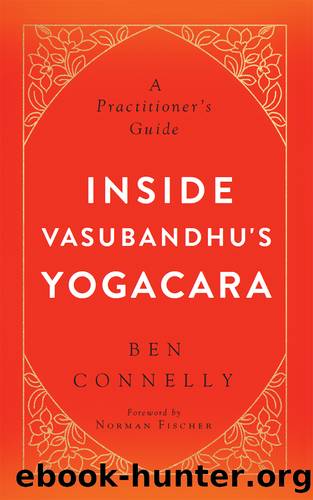Inside Vasubandhu's Yogacara_A Practitioner's Guide by Ben Connelly

Author:Ben Connelly [Connelly, Ben]
Language: eng
Format: epub
Tags: Religion, buddhism, General, Sacred Writings, Psychology of Religion
ISBN: 9781614292845
Google: o9ycDQAAQBAJ
Amazon: 1614292841
Goodreads: 29430534
Publisher: Simon and Schuster
Published: 2016-12-06T00:00:00+00:00
Organ /
Sense Base
Consciousness
Sense Object
Eye
Eye Consciousness
Sight
Ear
Ear Consciousness
Sound
Nose
Nose Consciousness
Smell
Tongue
Tongue Consciousness
Taste
Body
Body Consciousness
Touch
Manas
Mano / Thought Consciousness
Thoughtâand all the other sense objects
This verse tells us that this awareness, knowing, mind, or thought consciousness always manifests except in a few circumstances: the realm of no thought, the two thought-Âfree meditation states, unconsciousness, and thought-Âfree sleep. Sometimes when we sleep, we dream, which means thought consciousness manifests, but sometimes there is no thought consciousness; this is thought-Âfree sleep. It is also sometimes true that there is no awareness when one is in a coma, under the influence of powerful drugs, or unconscious for some other reason. There are also states of deep meditation where no awareness appears. These are the two specific meditation states that Vasubandhu references here. To be clear, this not does describe a state of meditation where there are no words moving through your mind, but there is awareness. Only when there is no awareness at all is one in thought-Âfree meditation.
The reference to âthe realm of no-Âthoughtâ is the only thing in the âThirty Versesâ that sits outside of the realm of twenty-Âfirst-Âcentury rational thought. This is a plane of existence occupied by beings who have no thought at any time. In Buddhist literature, there are many realms: hells, heavens, the realms of fighting spirits and animals, of humans, as well as the realm of no-Âthought. It is popular in the modern world to explain these as psychological realms or archetypal realms. If one reads ancient Indian texts, however, it seems quite clear that people understood these as literal realms in which one could be reborn. Although a great deal of the âThirty Versesâ is devoted to working with karma, at no other point do they present anything explicitly pertaining to rebirth. All the teachings in this work, so far, have been perfectly understandable and applicable to practicing to be well and promote wellness in this very life. Yet, there is this mention of the realm of no-Âthought. Iâll leave the subject of rebirth to others and just ask this: If what weâre seeing is a projection of our karma and we cannot ultimately know what the âexternalâ world is, as Vasubandhu states, does it really matter whether the realm of no-Âthought is a separate plane of existence or merely a psychological realm? Either way, this moment is our opportunity to practice for the well-Âbeing of the world. If we find ourselves in the realm of no-Âthought, we may just have to take a break from this noble work and resume when we are reborn where thought manifests. If we donât find ourselves in the realm of no-Âthought, letâs take care of what is here in our awareness.
Download
This site does not store any files on its server. We only index and link to content provided by other sites. Please contact the content providers to delete copyright contents if any and email us, we'll remove relevant links or contents immediately.
The Lost Art of Listening by Michael P. Nichols(7411)
Why I Am Not A Calvinist by Dr. Peter S. Ruckman(4103)
The Rosicrucians by Christopher McIntosh(3467)
Wicca: a guide for the solitary practitioner by Scott Cunningham(3127)
Signature in the Cell: DNA and the Evidence for Intelligent Design by Stephen C. Meyer(3075)
Real Sex by Lauren F. Winner(2968)
The Holy Spirit by Billy Graham(2894)
To Light a Sacred Flame by Silver RavenWolf(2768)
The End of Faith by Sam Harris(2691)
The Gnostic Gospels by Pagels Elaine(2472)
Waking Up by Sam Harris(2392)
Nine Parts of Desire by Geraldine Brooks(2328)
Jesus by Paul Johnson(2311)
Devil, The by Almond Philip C(2283)
The God delusion by Richard Dawkins(2266)
Heavens on Earth by Michael Shermer(2238)
Kundalini by Gopi Krishna(2137)
Chosen by God by R. C. Sproul(2123)
The Nature of Consciousness by Rupert Spira(2048)
